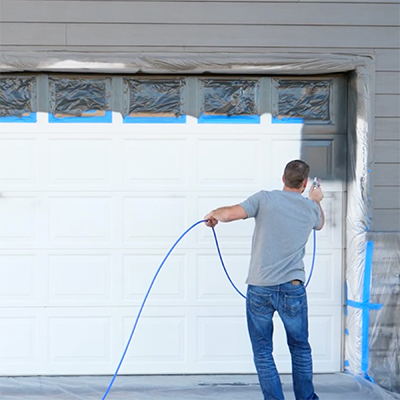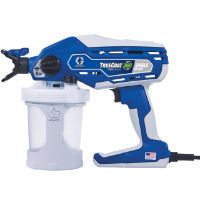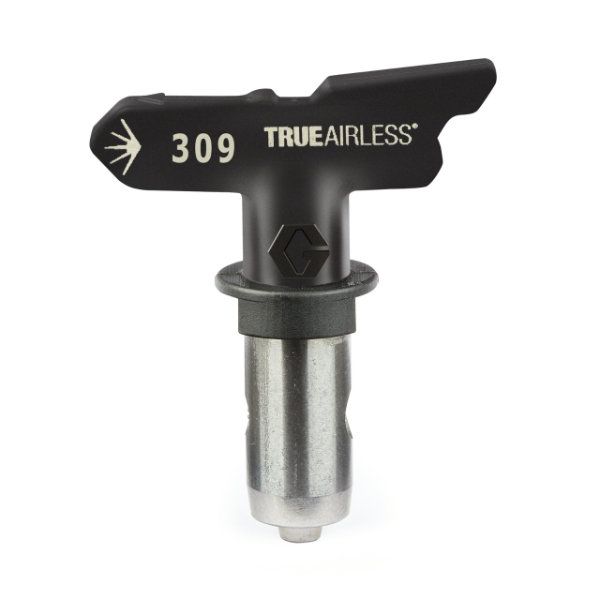HOW TO SPRAY PAINT A GARAGE DOOR USING A PAINT SPRAYER
Project overview
Spray painting a garage door is an easy one-day project. With all the angled panels of modern garage doors, spraying is quicker and easier than brushing or rolling. It’s really the best way to get a professional, smooth, even finish. Learn how to paint garage doors with this guide.
Safety notice: Whenever operating spray equipment, take proper safety precautions, stay alert, and be mindful of potential hazards. Wear protective gear such as gloves, safety glasses/goggles, spray sock (hood), hat, proper footwear, dust masks and respirators. Make sure there is adequate ventilation. If you’re painting in the vicinity of appliances, turn them off. (See Safety Precautions in your Sprayer Operation Manual.) Always refer to the specific instructions and safety procedures for the spray equipment you are using.

WATCH: How to paint your garage door with an airless sprayer (3:25)
Suggested tools & equipment
- Magnum by Graco paint sprayer for garage doors (visit Paint Sprayer category page to compare models)
- Paint/Stain
- Spray tips – a wider spray pattern for large surfaces and a narrow size for smaller surfaces
- Buckets for priming sprayer and cleanup (two needed)
- Stir sticks
- Paint strainer bag, if available – helps prevent tip plugs and provides a better finish
- Tarps, drop cloths, or plastic sheeting
- Masking tape
- Paint brush for touch-ups
- Tip Extensions (optional, see product details – for hard-to-reach areas that would otherwise require a ladder or would be difficult to spray (i.e. behind bushes)
- Pressure Roller attachment (optional, see product details)
- Additional airless hose sections if needed (see product details)
- Pump Armor storage fluid (see pump protectant product details)
- Cleaning rags
- Stiff nylon brushes for cleanup
Getting started/prep
- Move all outdoor furniture or any other items such as a grill away from the area to be sprayed. Allow plenty of space for your tools and equipment. Tape off any trim, and cover any surfaces you don’t want sprayed such as windows or shrubs with plastic.
- Use a pressure washer and cleaning solution to wash the entire area that is to be painted. Allow significant time for the surface to dry.
- Remove any dirt, mildew, or mould, and scrape off any peeling paint.
- Repair any damaged areas, sand any rough surfaces and caulk gaps as needed.
Pro tips
It’s best to plan your project on a day that’s not windy. The wind could affect your spray pattern. If there’s only a slight wind, spray with the direction it’s blowing.
If you’re covering up an uneven finish, possibly where you’ve done a lot of scraping, spray a coat of primer before painting. This will allow the topcoat to adhere stronger to the surface.
Spraying
- Select the spray tip that’s best suited for the paint you are using and the surface to be sprayed. Be sure the tip’s hole size does not exceed the maximum capacity of your sprayer (see manual).
- Pour your paint through a strainer (if available), to get rid of any dried sediment. If you’re using paint from multiple containers, mix it together in an empty 10-litre container to ensure consistent colour even if small colour differences exist between individual paint cans.
- If you don’t have a lot of spraying experience, practice spraying on a piece of cardboard. This is where you can fine-tune your technique and adjust the sprayer for the best spray pattern:
- Hold the spray tip approximately 30 cm from the surface.
- Pull the gun trigger after starting each stroke, then release the trigger before the end of each stroke.
- The gun must be moving when the trigger is pulled and released. This will create a fuzzy edge around the entire spray pattern to help create an even finish.
- Aim at the middle of each previous pass so you’ll overlap it by 50%.
- Flex your wrist so the front of the sprayer remains perpendicular to the surface. Fanning the sprayer one way or the other will result in uneven spray patterns.
- Spraying horizontally, work in sections only as far as you can comfortably reach.
- To achieve the best spray pattern, always start at the lowest pressure and increase, until you achieve the desired results.
- Frame in the door. Spray all the way around and windows, then start at the top and work your way down.
Clean-up
- Allow significant time for the paint to dry before removing tape from your trim. This will result in crisp, clean lines.
- Remove all coverings from shrubs, bushes and plants. Carefully remove all tape and plastic covering from the window and door trim.
- Replace any hardware, such as lighting fixtures, that you removed.
- Clean your airless paint sprayer after each use. Follow the directions in your user’s manual for Power Flush cleaning with water-based materials or use the bucket method of cleaning if applicable. For more information, refer to your Sprayer Operation Manual.
- Return any other items (furniture, etc.) to their proper place.
Looking for more videos to watch?
Check out our Education Centre with videos that cover product preparation, start-up and clean-up tips, spraying advice, troubleshooting and much more.
Related Projects
Railings
Discover Magnum by Graco's tips to paint banisters and stair railings using high quality paint sprayers. Protect your railings from sun and weather.
Outdoor furniture
Learn how to spray paint patio furniture with a Magnum by Graco paint sprayer. Magnum by Graco sprayers are perfect for painting outdoor garden furniture.
Sheds
Learn how to spray paint sheds with sprayers by Magnum by Graco. Applying a new coat of paint or stain is easy with Magnum by Graco sprayers.
Related projects
Railings
Discover Magnum by Graco's tips to paint banisters and stair railings using high quality paint sprayers. Protect your railings from sun and weather.
Outdoor furniture
Learn how to spray paint patio furniture with a Magnum by Graco paint sprayer. Magnum by Graco sprayers are perfect for painting outdoor garden furniture.
Sheds
Learn how to spray paint sheds with sprayers by Magnum by Graco. Applying a new coat of paint or stain is easy with Magnum by Graco sprayers.
Do you have any product questions?
Register your unit
Register your product and receive a free bottle of Pump Armor, a storage fluid that extends the life of your pump.












